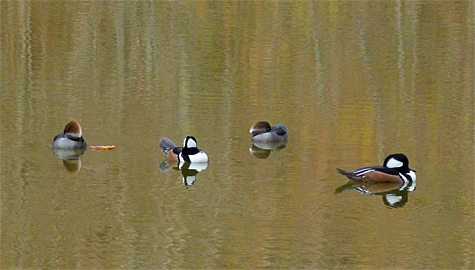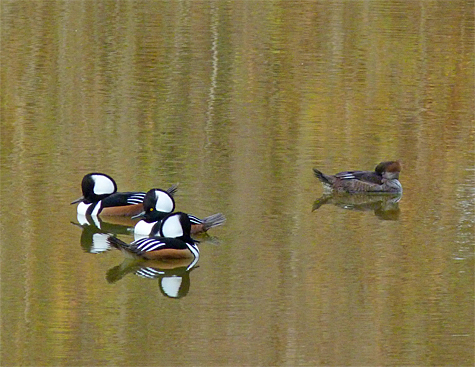On November 1st, I reported that a male Hooded Merganser arrived in our Wetlands. That bird was by itself until Saturday, two days later, when a female showed up. On Tuesday (11/6) when I made my rounds through Explore the Wild I saw five birds. There are now eight.

According to most range maps, Hooded Mergansers are permanent residents in our area. Perhaps they are, but I don’t see them here after mid-April, and that’s usually a non-breeding individual that lingers a bit too long. Most of our mergansers leave sometime near the end of March and return in November.

As soon as they arrive in the fall the males begin their pair-bond displays, bobbing their heads, rearing back and uttering a low, rolling croaking sound in an attempt to impress the females. It seems that the pairs are usually formed by the time winter rolls around, but the displays may continue until it’s time to head back north to breed. I believe the additional displays are to reinforce the pair-bonds made earlier in the season or to ward off males who have not yet formed bonds with a female.

We may see more mergs move in as the season progresses, so keep your eyes opened for them. I’ve seen as many as fifteen at a time in the Wetlands.
Welcome back!
I just read somewhere else about ducks “pair-bonding” in the fall. Are these ducks that do not mate for life? These Mergansers are beautiful birds.
Good question. Apparently only geese and swans pair for life. Ducks form seasonal pair-bonds. However, this from Ducks Unlimited suggests that maybe something else may be going on with our mergansers:
“An interesting twist on seasonal monogamy occurs in some cavity nesters and sea ducks that do not form bonds until their second year of life. Research has shown that some goldeneye pairs reunite each year on the wintering grounds and return to their previous breeding territory. This system is possible only in species that exhibit strong philopatry to both wintering and breeding sites. Philopatry is a behavior in which individuals return to the exact site, either on the breeding or wintering ground, from the previous year, enabling pairs to find each other. Males do not participate in raising the young, but they do defend females. Re-pairing is also suspected for buffleheads, long-tailed ducks, harlequin ducks and common eiders.”
Hooded Mergansers do not breed until their second year and are cavity nesters. And, I’d be willing to bet that we see many of the same individuals in our Wetlands each winter, with some variation.